At some point, you and your cat will need to travel. You may feel stressed by the idea, but with a bit of effort and planning, cats can learn to cope with the trip. Preparing your cat beforehand can make the experience less stressful for both of you.
At some point, you and your cat will need to travel. You may feel stressed by the idea, but with a bit of effort and planning, cats can learn to cope with the trip. Preparing your cat beforehand can make the experience less stressful for both of you.
Preparation
How much preparation is needed depends largely on how you are traveling and the length of time the trip will take. Know the requirements for traveling with your cat well in advance. Most transportation companies have guidelines for cat travel including approved carriers and health requirements. When flying, make sure that your cat will be in a temperature and pressure-controlled area. Extra caution is needed with breeds like Persians and Himalayans as flat-faced cats cannot handle temperature or pressure changes easily.
If your cat has shown distress during past travels, be sure to talk with your veterinarian. If a health certificate is required, your cat will need a veterinary visit. Discuss the use of medications to help your cat feel more comfortable.
Large crate set up with litter box
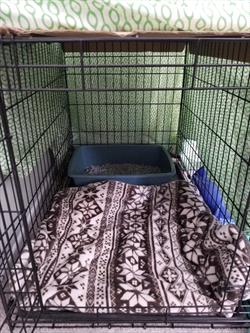
A large dog crate can be a great space for cats during longer car rides. A blanket draped over the crate can create a feeling of safety. Photo courtesy of Katharine Schwarz, RVT, KPA CTP
|
Cat in large crate
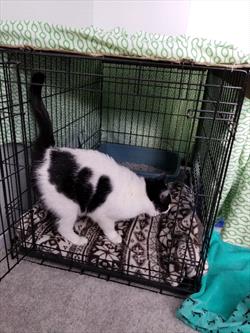
Introduce your cat to the crate early by feeding treats in the crate. Photo courtesy of Katharine Schwarz, RVT, KPA CTP
|
Cat in large crate with treat
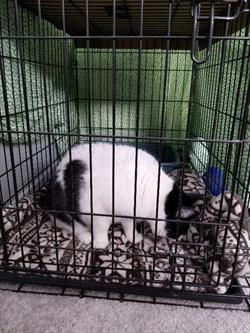
Eventually, you can close the crate for brief periods of time. Photo courtesy of Katharine Schwarz, RVT, KPA CTP
|
Have the appropriate carrier ready well in advance of your trip and start teaching your cat that the carrier is a great place to be. For long car rides, consider using a large dog crate that can accommodate a small litter box along with space for your cat to rest comfortably.
If you are flying or using any other public transportation, the size of the carrier will likely be limited. Use a pee pad to line the carrier in case of accidents. Cats who are accustomed to wearing a harness with a leash and are comfortable in public may be able to take breaks from the carrier during long trips. Be cautious even when your cat is used to wearing a harness or leash, as some cats may easily startle and try to escape.
Acclimating to the Car
If you are driving, you can acclimate your cat to the carrier as well as the car. Complete the following steps over multiple sessions while feeding your cat treats and watching their body language. Your cat should be more relaxed each session; if not, then stop and go back to the last most successful step.
- Once your cat is comfortable in their carrier, practice picking up the carrier for brief periods. The goal is to place the carrier in the car while your cat stays relaxed.
- Once your cat is in their carrier in the car, feed them some treats.
- Turn on the car and remain parked, feeding your cat treats.
- Drive a short distance such as up and down the driveway. Ideally, a passenger can feed treats during this step.
- If your cat remains relaxed, increase the distance for each session.
Cat in small carrier
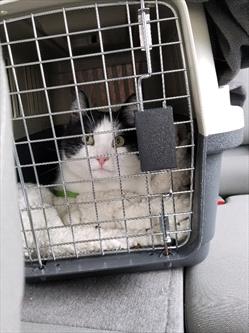
A smaller carrier is appropriate for shorter durations or public transportation. Photo courtesy of Katharine Schwarz, RVT, KPA CTP.
|
Cat treats to give while traveling
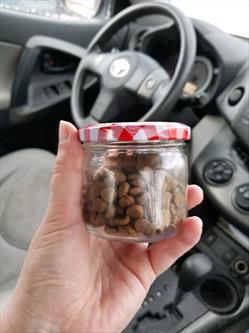
Bring kibble or treats for your cat to make a positive experience. Photo courtesy of Katharine Schwarz, RVT, KPA CTP.
|
Cat trick while traveling
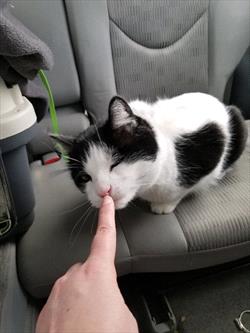
Practicing some tricks in the car such as "touch" can help your cat feel more positive. Photo courtesy of Katharine Schwarz, RVT, KPA CTP.
|
Cat trick while in car
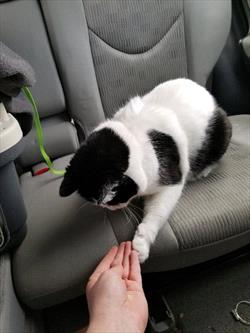
Practicing some tricks in the car such as "paw" can help your cat feel more positive. Photo courtesy of Katharine Schwarz, RVT, KPA CTP.
|
During the Trip
Allow plenty of travel time to avoid added stress for yourself and your cat. Give your cat some time to adjust to the car before you start driving. Bring your cat’s breakfast with you to feed in small portions throughout the trip. Using tricks your cat knows, like "touch" or "paw", can help your cat focus on something they enjoy.
After Arrival
Your cat will need some time to feel comfortable in their new environment. Prepare a room or safe haven area for them so they can relax. Make sure they have everything they need in this space such as a litter box, hiding spot, scratching post, resting area, food and water. Wait to introduce your cat to any other pets in the home until after they have acclimated.